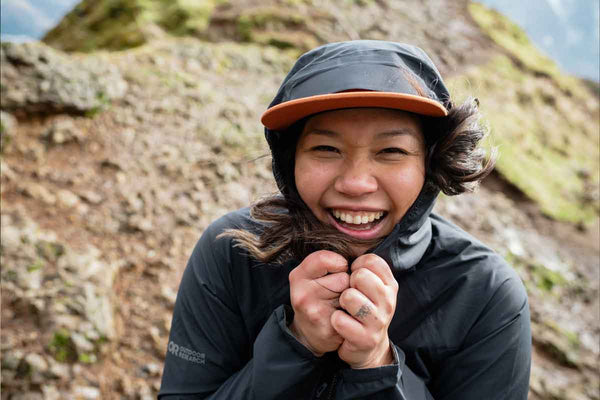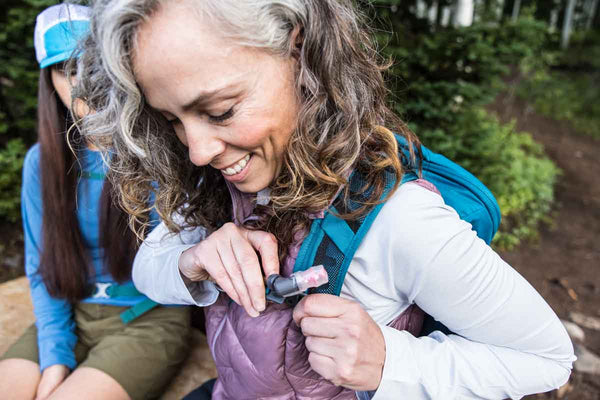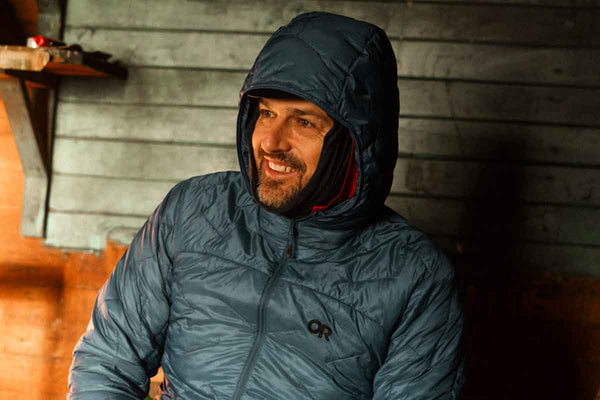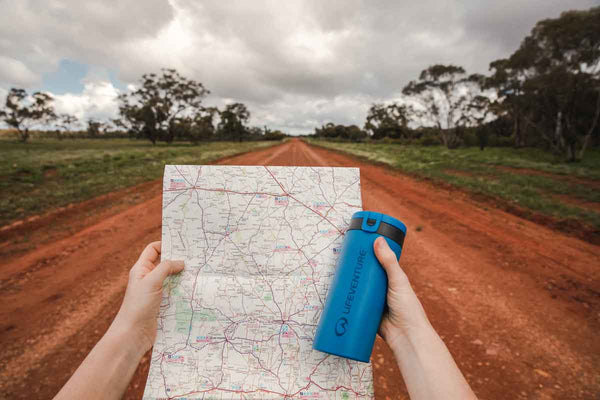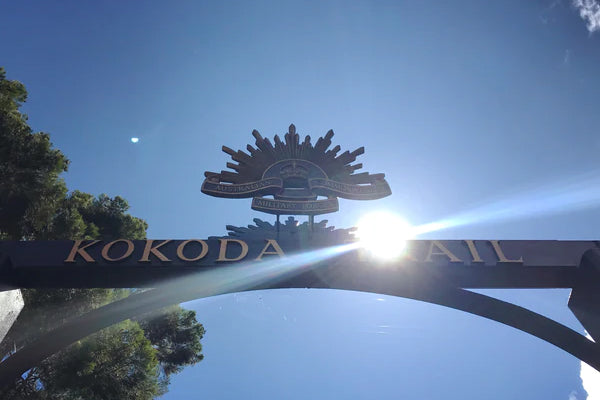
Trek & Travel Reviews the Kokoda Trail's Best Trekking Companies
In accordance with Trek & Travel's 'We've been there' ethic, two of our senior staff members have undertaken the Kokoda Trail in the last twelve months, with two of the track's best trekking companies, all the better to advise our customers. Since Dan (Web Co-ordinator) and Jemima (Store Manager) walked the track with different operators, we thought it'd be interesting to compare their treks for anyone out there who is looking for direction in choosing a Kokoda tour operator. We asked them both a set of questions which should give you some insight into each company's style, as well as some useful tips on walking the track itself.

Describe your rough trek itinerary
Jemima: I walked the Kokoda track with Back Track Adventures on their 9 day program from South to North (aka from Owers Corner to Kokoda). It wasn’t the whole 9 full days of hard trekking and 8 nights sleeping in hot muddy mosquito infested jungle that I was expecting. In fact it was more 7 days of hard trekking, one half a day of transport to the start of the track, one afternoon on the back of a truck from Kokoda to Popondetta and a night at a lovely homestay in Popondetta. Back Track also observes the Sabbath in accordance with the local porters religious views so we had a rest day carefully timed in their village. So all in all total walking days was 7 with 7 nights on the track.
Dan: I went with Charlie Lynn's Adventure Kokoda, which apparently is the oldest continually-operating company on the trail. Ours was a 10 day, south to north crossing. The extra time allowed us to spend a whole day exploring the Myola plateau, including a visit to the P40 fighter plane crash site which was pretty cool, and fit in some side trips that not all treks reach, such as Abuari village. It was great to be flying out of Kokoda at the end, too, rather than endure the four-hour ride in the back of a pickup to Popondetta.
How did you find the service in general?
Jemima: The service was great, don’t be fooled tho. This isn’t a luxury tour. And it’s not supposed to be, your not going to feel like you’ve achieved anything unless you get a little muddy and bruised.
Dan: Impeccable. Our leader Major Chad Sherrin was ex-military and showed us how a 71 year-old can outperform people decades younger than himself. Under the circumstances (i.e. trekking in a wet, muddy, steep, humid jungle environment) I didn't feel he could have organised it much better. They were a couple of instances when the crew made mistakes but they were soon sorted out.
Was the trip successful?
Jemima: There were 12 of us who started. Mixed ages from 15 years old to 60 plus, exactly half women half men. A few had distant relatives who had fought there, some who had died there too, a couple were history buffs, a few were raising money for charity, one young woman was trekking in the memory of her father who had passed away, while some were just patriotic and up for a challenge, mental and physical.
For me, I was there for the landscape, I’m not immediately drawn to the idea of trekking in the jungle with its humidity, mud, rough tracks and bugs. I usually opt for cooler temperatures like Tassie or the thin-air big mountain ranges of India and Nepal. I wanted to be out of my comfort zone. I didn’t know what to expect but I did know I would be confronted with the brutal history, difficult terrain and who knows - I might come out with a little sense of patriotism too.
From the 12 of us who started, 11 finished. One person had taken a few bad tumbles which made her a bit shaky on her feet, delaying her arrival into camp each night. By the Lunch time on the third day our trek leader Gareth eventually caught up to us, “She had to make the tough decision to go back”, given the rate of walking and the upcoming challenges I suspect he may have encouraged her decision.
Dan: Well, it was for five of us. The other two were evacuated on Day 2 from separate incidents. One fell awkwardly on his pole and dislocated his shoulder. The other had a dizzy spell, blacked out and fell over. The rest of us had a great time. The evacuees were both alright afterwards though. It was an (apparently rare) all male group.
How tough was the hiking?
Jemima: The Kokoda track was not unknown to me. I knew it would be hard. And it was, in part. It was hard but there were loads of rest stops, too many for my ego and sometimes I was impatient to keep moving, at other times I embraced the stillness. I think the hardest part of any truly gruelling slog is in the mind, the mentality of 'I can’t do this'. I trained hard, and reprimanded myself for not training harder. I wasn’t the fittest person in the group but I wasn’t the unfittest. The parts I struggled with, so did everyone else, the parts I thought were pleasant and easy, so did everyone else.
The best training I feel I did for Kokoda, apart from hills and pack training, was to train my mind to deal with the unpleasantness of working hard in hot, muggy conditions. My method of torture was hot yoga, which got me used to pushing my body to the limits in extreme humidity and gave me the tools to deal with mind chatter.
Dan: It was harder than I expected. I'd heard a lot of opinions beforehand and done a fair amount of training, so I thought I'd breeze it. (Check out Dan's Kokoda Training Tips!) That didn't happen, but while the 11 hour days were challenging, it wasn't quite too relentless to be enjoyable, so it was probably perfect for me. Chad and Kaile, the front man, planned the breaks extremely well. Chad never implied that we could stop for a rest whenever we felt like it, so none of us did. We all always plodded on until the planned break, and that worked really well for our group.
Did you hire a Personal Porter? Did he do a good job?
Jemima: I’m a fairly stubborn person, an independent woman with a slight Napoleon complex, but honestly having Max around was a blessing and really enhanced my experience. He’s a senior trekker and often a head guide, but they take it in turns and lucky for me this trip he was my porter. He was a gentleman strong enough to lift me down muddy tracks that were so steep there was no other way but to slide down them. He gave me space to be independent and made me feel like I was really achieving something and would appear out of nowhere to help me down or up a tricky section. His hand often lightly on the back of my pack to jolt me up in the split second before a potentially nasty fall or slide, or a gently lift the bottom of my backpack as I heaved myself up over a rock, root or fallen tree.
I carried less weight, a small pack, I was lighter on my feet and my back and shoulders didn’t ache at the end of the day. Max would set up my tent and pack it down every day, after a long day in the mud it was so nice to find my tent decorated with local flowers that he’d picked along the way, and a large leaf at the door of my tent as a welcome mat.
He felt like a teammate. Someone to quietly encourage me, talk for hours, exchange stories, lie about how much longer it was or laugh at himself when he’d tell me it was the last uphill (it never was). Max became more than just my porter, he became my Kokoda Angel, and it was that experience with him that made me start to really understand the relationship between the Australian Soldiers and the Fuzzy Wuzzy Angels.
Dan: I carried my own pack so I didn't have a porter, but I saw plenty of evidence that those guys are much more than just carriers. Their secondary job was to look after you on the steeper and more problematic sections of the trail. Regardless of not hiring anyone, on the steep descents I often had a quiet shadow behind me ready to catch me should I slip and fall. They really were very caring and gentle people.
How were the crew looked after?
Jemima: I’ve never seen a group of guys laugh and joke around more than our crew. They sang, they took great care of us, lighting fires for us on chilly night in the mountains. They all got paid well and tipped well by the trekkers, too. Everyone had quality footwear and loads of gear.
Dan: They got paid well above minimum wage per day because obviously they don't get work every day, just a few times per year. They had full trekking uniforms, plenty of food and slept in shelters with firewood. Most were shy and quiet when around the clients but when they were all together you could hear them laughing for miles. AK treat their workforce as an extended family, as long as they are loyal - they mustn't work for other trekking companies.This even extends to paying for their family's education and medical bills on occasion.
How knowledgeable and enthusiastic was your guide?
Jemima: Gareth was our guide, a lovely Brisbane man with calves that would kill a man just by looking at them. I mean these calves were something else, tree trucks on steroids, but I digress, what were we talking about, oh yes... knowledge.
I’ve been on historic tours before and often they are painfully biased. I was prepared that this one would be too but I was surprised at how empathetic Gareth was to the Japanese Soldiers. Yes, we got all the heroics and bloodiness, sobriety of war and how it affected our side, but I didn’t expect to gain some insight and understanding and dare I say sympathy towards the Japanese men. Gareth humanised something I’d always considered a faceless monster. He gave these men faces and names and stories and talked about the cultural pressures they faced at home.
Dan: I couldn't believe the depth of Chad's knowledge of military history. He knew the entire campaign back to front including names, dates, battles, minor skirmishes, each soldier's fate and pre-war career. And not just for Kokoda, for the whole Pacific war and army structure. He served in Vietnam before working at the army's jungle training school in Malaysia, and retired as a Major. And his enthusiasm, not just about the sacrifice of the diggers (he used to work for Legacy, a charity dedicated to the families of deceased veterans) but about the beauty of the forest was amazing for someone on their 87th trek. He'd often linger behind to take photos of his favourite trees.
What first aid qualifications and emergency communications did the group have?
Jemima: Other than the two nurses and the vet who happened to be trekkers on the trek, Gareth carried an extensive first aid kit and satellite phone.
Dan: Chad had a Remote Area First Aid qualification, renewed each year. His first aid kit was very impressive. We also had a native Trek Dokta who had a lesser qualification but he was never called into action. Chad carried a SPOT tracker which sent our location back to AK HQ every evening, and someone there updated the AK Facebook page to confirm to worried relatives that we were still alive. He also carried a satellite phone, Garmin GPS, regular phone and two cameras to take photos of the trek. He was a machine.
How was the food?
Jemima: It's not the Hilton, but I didn’t care. Honestly, I loved every minute of the Kokoda track, and although the food wasn't the highlight, I wouldn't have had it any other way. I don’t blame the chef though, he definitely did the best he could with the very limited ingredients. I got over the noodles for lunch and rotating mince dishes. Hearing about the rations the Australian soldiers endured, I was beyond grateful and humbled by each meal. I would have LOVED to try more traditional dishes,. Especially the two nights we stayed in their village.
Honestly, even if I'd been presented with Michelin star food every meal, I was so exhausted and starving it really didn't matter what I was shoveling into my face. Seriously, just FEED ME!
Dan: Pretty good. It was plentiful but got a bit repetitive. Breakfast: Weet-bix & muesli with powdered milk, canned fruit, baked beans or spaghetti. Lunch: sliced spam and canned cheese with hot 2-min noodles or rice. Then crackers or mountain bread with preserves. Dinner: Rice, pasta or mashed potato with a sauce made from tinned food. I would have liked to have eaten local foods like sweet potato, coconut, banana and taro, but apparently supply from the villagers is not reliable enough to plan this in advance. We did get fresh baked scones a couple of times, and once some of the aforementioned dishes, and we loved it! You can also buy some interesting stuff from villagers along the way - small, strange nuts and ex-poisonous fungi that tasted very ... interesting.
What was the camp setup?
Jemima: Each campsite we stayed at was really lovely. All but one had a clean creek flowing through it to bath in. It was off season so the toilets were clean, still full of spiders and other creepy crawlies and because it was off season there was only one night were we had to share the site with two other groups. In fact it was the only time we saw any other groups.
Dan: Each trekker had a two-person tunnel tent to themselves, which was carried and erected/taken down by the 'tent boys'. There was always an open-sided dining shelter and usually a clothes drying shelter where we could build a fire. There were long drop toilets with plastic seats and always some way of washing, either stream or shower. We needed only cup, bowl and utensils. The rest was provided.
How does your chosen company give back to the villagers?
Jemima: Backtrack has a really good reputation for being one of the best responsible tour operators in Australia, they employ all of the crew, chef and porters from local villages along the Kokoda track. They work with locally own business partners in and encourage trekkers to include themselves in local community events, like local markets with handmade bags and hats, visit the local church, school and village hospital (as a visitor not as a patient!)
They also encourage any trekkers wanting souvenirs to buy locally, making sure that products have been made locally and ethically. Our guide even went with a few trekkers to a market in Port Moresby to help them make sure their money was going directly to the community.
Dan: Charlie Lynn is extremely focused on helping the communities on the trail, and to that end has founded an NGO called Network Kokoda as a not-for-profit charity to support his workers, their families and the villagers who live and work along the Kokoda Trail through sustainable initiatives. We saw this first-hand at the NK learning centre which teaches local women skills like handling money, sewing and baking, and women's rights.etc He really does a lot, too much to mention here.
What surprised you most about the trip?
Jemima: I was blown away by how pretty the landscape was. I mean you see the documentaries with mud and gore, but seriously this place was ferngully magical!
Dan: It was harder than I thought. I wasn't expecting that amount of military history and I soaked it all up like a sponge. Ditto the memorial services - way more involved than I was expecting, a pleasant surprise. Also how quiet it was: we passed five groups going the opposite way and were passed by one going S-N. Only being caught twice in tropical afternoon downpours was a solid result.
What were your highlights and lowlights?
Jemima: Highlights: swimming in the water every night; running through the swamp in an afternoon swap like a pack of wild animals.??
Lowlights: right at the end, the long slog downhill. My knees were sore and it was getting hotter and hotter, it didn’t seem to be ending. I was over it. The fun part was over, the trek itself was over. This was just torture; also, the truck ride from Kokoda to Popondetta - 100km that takes 4 hours on a bumpy dusty road with a bunch of trekkers who had just completed once of the world's toughest treks and wanted to celebrate. It was exhausting.
Dan:
Highlights: the day at Myola Lakes and the hot shower at Bomber camp! That was a nice surprise; the depth of feeling during the Isurava memorial service; hot scones; the crew waking us up on the final morning with a beautiful song; cold beer back at the lodge!
Lowlights: a lot of pesky flies around the Yodda valley; all my clothes smelling of smoke; not seeing any birds of paradise; day nine was a long one - I was ready to finish then.
What gear did the company supply, and what did you need to bring yourself?
Jemima: Back Track supplied all the tents, and anything meal related - mugs, plates & cutlery. We had to supply our own sleeping bags and sleeping mats (which they also hire out if you give them enough time). We were given out porter packs the night before we left port moresby, The packs could hold about 70L of gear and they would be carried by our porters for the trek. Into my porter pack I put the following; My sleeping bag, sleeping mat, extra socks, change of clothes, my first aid kit, and my toiletries, which consisted of a small bar of soap, toilet paper, tooth brush, tooth paste, I was embracing the jungle girl in me by forgoing all creature comforts, including my hairbrush, my water sterilisation system (my beloved steripen/electrolytes/spare water bottle). And snacks, loads and loads of snacks!
Before departure Back Track sent each trekker a zipper document case with loads on information, a map and a Back Track Kokoda T-shirt and Certificate of Achievement at the end (which I may have framed on my desk at work).
My day pack (not supplied by the company) I had packed; my foot care regime; a small foot towel, hikers wool, spare socks and sock liners, tea tree foot powder, and my river crossing sandals, a lightweight fleece, a small drop sheet, a shirt, hat, sunscreen and mosquito repellant.
Dan: It was a similar deal with AK. They also gave us Polo shirts, trail maps of their own design and a certificate at the end.
What sort of boots would you advise re: waterproof or breathable?
Jemima: I went with waterproof and I’d recommend waterproof. But its only one piece of the puzzle really. You’re feet are only going to stay dry if you’ve got a good system
Here’s my system and it worked perfectly:
- Liner sock - Coolmax for ultimate wicking and blister prevention
- Trekker sock - and a pretty thick one at that, cushion and moisture control. Don’t assume thick means hot.
- Good pair of supportive waterproof boots, I went with a leather mid boot with Gore-Tex (gasp! Isn't that sacrilege ?!) No, not at all. I went with Leather because they’re my most comfortable boots, I went with a mid cut because I’m not a heavy person, I had walking poles and my porter was doing the heavy lifting so my pack was pretty light, and Gore-Tex, I don’t care what they say about GTX on the Kokoda track, for me Gore-Tex was the BEST!
- GAITERS!!! And I seriously can’t stress this enough! Water WILL run down your leg and straight into your boots unless you’ve got gaiters.
- Foot Care regime: In my day pack I kept on me a little bag of foot care goodies so I could tend to my feet at any time on the hike,
- Hikers Wool for any hot spots (shoved between your skin and the liner sock)
- A foot towel (different from the body towel, to dry off feet after river crossings)
- Tea Tree Powder - antibacterial and anti-fungal. I’d sprinkle this on just before I put on any clean dry socks, and cover my feet every night as the last thing before I went to bed to prevent trench foot.
- A spare set of trekker socks AND a spare set of liners. You never know when you’re going to fall into a river/swap/mud puddle. You may even want to change your socks half way through the day.
- Blister packs and Strapping tape. Don’t keep walking when you know you’ve got a blister; stop and fix it. You’ll be grateful you did.
Dan: Waterproof membrane, no question. I only got wet feet once, crossing a bridge that was underwater. The rest of the time my boots and gaiters handled it or I used my sandals. I don't particularly have a problem with hot or sweaty feet so Gore-Tex is a no-brainer.

Inside I used Bridgedale Merino Fusion Trekkers with Injinji Performance Liners, and if I ever got a hot spot (the beginnings of a blister) I stuck on some Hiker's Wool which killed it dead.

